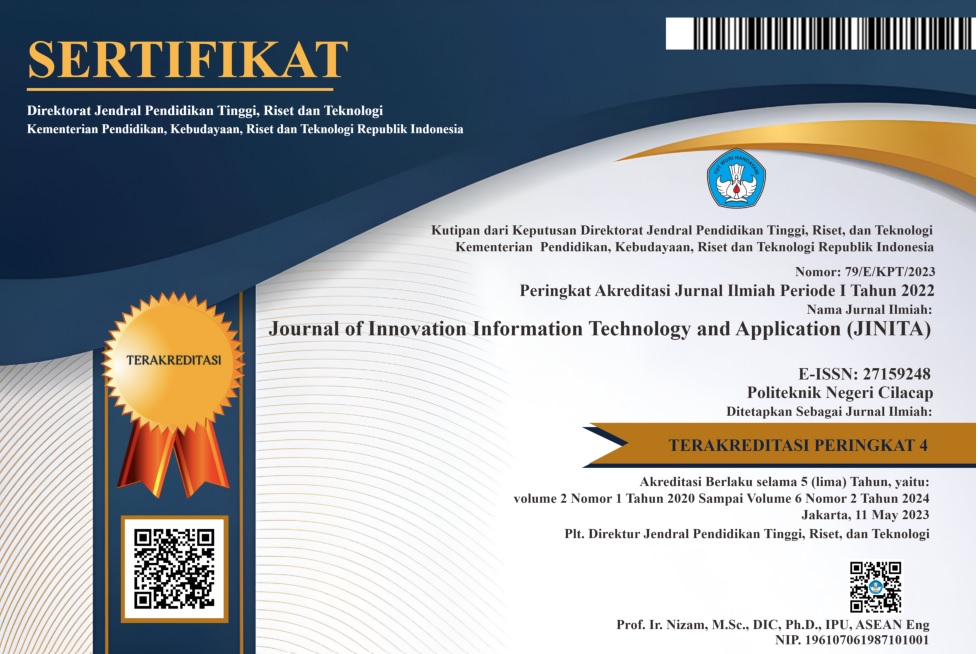Automatic Screen Reader Using JITBIT for Sending Message on WhatsApp Messenger
 Abstract views: 195
,
Abstract views: 195
,
 PDF downloads: 185
PDF downloads: 185
Abstract
The current sales trend uses more online transaction concepts. The use of digitalization in online transactions and marketing is very important for businesses in increasing sales results to the maximum and on target. One way to increase this is by promoting on social media such as WhatsApp. Limited consumer contact makes it difficult for business actors to carry out promotions, so a database of consumer contacts is needed that can be maximized. In addition, problems in the process of sending manual messages can be overcome by using automatic message-sending actions so that promotions can be carried out automatically and quickly. The sending process is assisted by an "IF-THEN" statement and a screen that can recognize color conditions so that the automatic action can be operated on other services. The main objective of this research is to create a service that can accommodate consumer contacts by sharing contacts between business actors and being able to send messages automatically on WhatsApp by utilizing JITBIT. The results of this study prove that using JITBIT can send messages automatically on WhatsApp and can be operated on other services such as web-based applications. The results of the tests that have been carried out show that the accuracy level of JITBIT can send messages 100% with a delivery speed of 12 – 12.39 seconds/message
References
Hootsuite, “Digital 2022: Indonesia In Global Digital Insights.,” https://www.hootsuite.com/research/social-trends, 2022, (accessed Dec. 11, 2022).
N. A. Abdullah et al., “Social Media as a Means to Enhance Business Performance,” 2020, (accessed Dec. 11, 2022).
V. A. Taha, T. Pencarelli, V. Škerháková, R. Fedorko, and M. Košíková, “The use of social media and its impact on shopping behavior of Slovak and Italian consumers during COVID-19 pandemic,” Sustainability (Switzerland), vol. 13, no. 4, pp. 1–19, Feb. 2021, doi: 10.3390/su13041710.
J. N. Sheth, “How social media will impact marketing media,” in Social Media Marketing: Emerging Concepts and Applications, Springer Singapore, 2018, pp. 3–18. doi: 10.1007/978-981-10-5323-8_1.
P. M. Aji, V. Nadhila, and L. Sanny, “Effect of social media marketing on instagram towards purchase intention: Evidence from Indonesia’s ready-to-drink tea industry,” International Journal of Data and Network Science, vol. 4, no. 2, pp. 91–104, 2020, doi: 10.5267/j.ijdns.2020.3.002.
Y. K. Dwivedi et al., “Setting the future of digital and social media marketing research: Perspectives and research propositions,” Int J Inf Manage, vol. 59, Aug. 2021, doi: 10.1016/j.ijinfomgt.2020.102168.
N. L. A. Sugiyantoro, M. Wijaya, and S. Supriyadi, “Benefits of WhatsApp as a Communication Media on Small Business Social Networks,” The Journal of Society and Media, vol. 6, no. 1, pp. 1–16, Apr. 2022, doi: 10.26740/jsm.v6n1.p1-16.
C. Barhoumi, “The Effectiveness of WhatsApp Mobile Learning Activities Guided by Activity Theory on Students’ Knowledge Management,” 2015.
P. Ellanti, A. Moriarty, F. Coughlan, and T. McCarthy, “The Use of WhatsApp Smartphone Messaging Improves Communication Efficiency within an Orthopaedic Surgery Team,” Cureus, Feb. 2017, doi: https://doi.org/10.7759/cureus.1040.
N. Omar, C. S. Mustaffa, and Z. A. Talib, “Receiving and Responding to WhatsApp Official Group Messages Among Employees: An Early Interpretation Analysis,” International Journal of Engineering & Technology, vol. 7, no. 4.38, p. 1030, Dec. 2018, doi: 10.14419/ijet.v7i4.38.27633.
B. Kommey, E. Tamakloe, J. O. Boateng, E. Ocupualor, and J. E. Ayarma, “Design and Implementation of a Local Area Network Based Multimedia Messaging Application,” Journal of Innovation Information Technology and Application (JINITA), vol. 4, no. 2, pp. 104–119, Dec. 2022, doi: 10.35970/jinita.v4i2.1545.
Yusuf Heriyanto, Anas Azhimi Qalban, and Iif Alfiatul Mukaromah, “Pengembangan Metode Login Two Factor Authentication (2FA) untuk Keamanan Sistem Informasi Akademik,” Journal of Innovation Information Technology and Application (JINITA), vol. 4, no. 2, pp. 142–150, Dec. 2022, doi: 10.35970/jinita.v4i2.1637.
Statistics and Data, “Most Popular Social Media,” https://statisticsanddata.org/data/most-popular-social-media-in-history/, 2022. (accessed Dec. 11, 2022).
S. v. Yulianto, L. D. Setia, and A. P. Atmaja, “The Use of Whatsapp Gateway for Automatic Notification System,” in Journal of Physics: Conference Series, Mar. 2021, vol. 1845, no. 1. doi: 10.1088/1742-6596/1845/1/012014.
R. Aulia, “Sistem Pemantauan Ruang Menggunakan Metode Background Subtraction dengan Notifikasi Whatsapp”, Jartel, vol. 5, no. 2, pp. 15-20, Nov. 2017.
Fei, Jennifer and Wolff, Jessica and Hotard, Michael and Ingham, Hannah and Khanna, Saurabh and Lawrence, Duncan and Tesfaye, Beza and Weinstein, Jeremy M. and Yasenov, Vasil and Hainmueller, Jens, Automated Chat Application Surveys Using Whatsapp: Evidence from Panel Surveys and a Mode Experiment. IZA Discussion Paper No. 15263, Available at SSRN: https://ssrn.com/abstract=4114839 or http://dx.doi.org/10.2139/ssrn.4114839.
R. Munadi, A. Rakhman, and D. Perdana, “Smart garage implementation and design using WhatsApp communication media,” Telkomnika (Telecommunication Computing Electronics and Control), vohttps://ejournal.pnc.ac.id/index.php/jinita/workflow/index/1752/4#l. 16, no. 3, pp. 1107–1113, Jun. 2018, doi: 10.12928/TELKOMNIKA.v16i3.8063.
Copyright (c) 2023 Alam Rahmatulloh, Faisal Muhammad Dzikry, Rahmi Nur Shofa, Randi Rizal

This work is licensed under a Creative Commons Attribution 4.0 International License.
Authors who publish with this journal agree to the following terms:
- Authors retain copyright and grant the journal right of first publication with the work simultaneously licensed under a Creative Commons Attribution License that allows others to share the work with an acknowledgement of the work's authorship and initial publication in this journal.
- Authors are able to enter into separate, additional contractual arrangements for the non-exclusive distribution of the journal's published version of the work (e.g., post it to an institutional repository or publish it in a book), with an acknowledgement of its initial publication in this journal.
- Authors are permitted and encouraged to post their work online (e.g., in institutional repositories or on their website) prior to and during the submission process, as it can lead to productive exchanges, as well as earlier and greater citation of published work (See The Effect of Open Access).
















